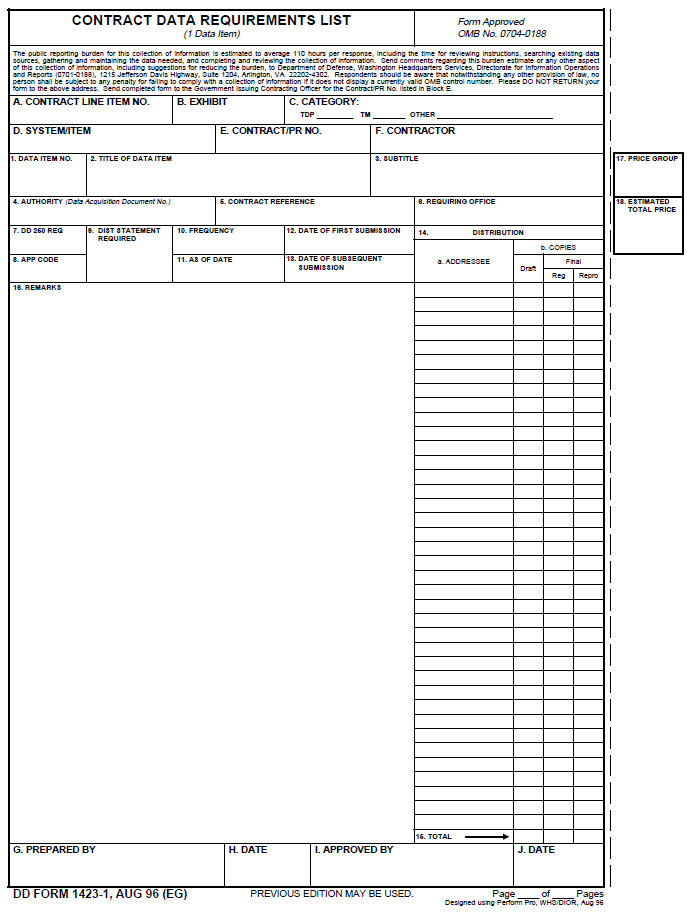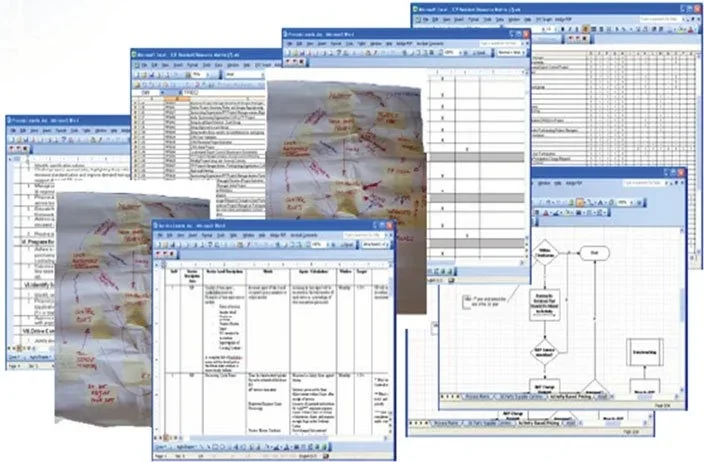Contract Deliverables CDRL Data Management for Aerospace and Defense Suppliers
CDRL data management is not a spreadsheet exercise for data managers nor a document management task for project planners!
Once upon a time, the process of managing Contract Data Requirement Lists (CDRL) and Subcontract Data Requirement Lists (SDRL) in support of government and commercial contracts in aerospace and defense was simple enough that data managers and project planners could perform most of what was required using spreadsheets.
Example DD Form 1423 for CDRL
As a reminder for new program and data managers, mandated by Defense Acquisition Regulation Supplements (DFARS) and described by AcqNotes , “The Contract Data Requirements List (CDRL) is a list of authorized data requirements for a specific procurement that forms part of a contract. It is comprised of either a single DD Form 1423, or a series of DD Forms 1423 containing data requirements and delivery information. The CDRL is the standard format for identifying potential data requirements in a solicitation, and deliverable data requirements in a contract. DFAR Subpart 215.470 requires the use of the CDRL in solicitations when the contract will require delivery of data.”
Historically, the CDRL data management function resided in the contracts department or program management office that provided administrative and financial oversight. Here, Data Managers were the resident go-to experts in collecting and transmitting all the information created and then needed by others over the lifecycle of a program. They did so often using elaborately crafted, well maintained, and zealously guarded spreadsheets, project calendars and document management tools.
The use of spreadsheets, whether sophisticated or rudimentary, worked well for many years because most of the effort involved was in the manual process of hunting down information in a variety of disparate sources before it could be entered and then used to fulfill contract obligations. The sources were numerous and could include documents, communications, and other artifacts originating in contracts, finance, engineering services, manufacturing, procurement, logistics, quality assurance, test, compliance, support services, and of course suppliers/subcontractors.
There were dozens of organization desks and desktop applications where the required data was just as likely to be found on paper in a folder instead of in a digital record on a disk. The role of data managers evolved to become similar to that of a crime-scene detective; chasing down the clues of where evidence was hiding out across an enterprise, including its subcontractor supply chain.
As a consequence, once all the information was on hand to submit a progress report, transmit an invoice, or resolve a payment dispute, there was little time left in the schedule for creating databases or custom code to automate data collection, validation, and distribution.
Surprisingly, this all worked fine for decades over programs that often spanned just as many years. And it did so despite manual workflows being inefficient, error-prone, onerous tasks that were resistant to automation.
Admittedly, these legacy processes survived longer than they should have because an office full of data clerks were able to bill hours against contracts ultimately paid for by the customer which was often a federal agency.
Furthermore, because most processes were ad-hoc in nature, there were few metrics available which sufficiently motivated managers to seek out problems or identify performance gaps, then prescribe corrective actions while assigning accountability by demanding metrics.
What Changed?
All this changed as legacy DM processes using spreadsheets and project plans became increasingly unreliable and unsustainable due to a confluence of trends and mounting impediments. Here are some of those challenges that CMstat has heard over the years from our customers seeking to improve their CDRL data management capabilities:
Contract data deliverables have become more numerous, complex, and interdependent. As a result of digital transformation, the volume, specificity, and type of CDRLs (e.g. program, financial, functional, engineering, logistical support, etc.) has created additional burdens to earning customer acceptance and receiving progress payments.
As contracts, Statements of Work (SOW), Work Breakdown Structures (WBS), and CDRLs became more complex, the programs involved more sub-contractors, Data Item Descriptions (DIDs), and interdependent milestones. The coordination of simultaneously incoming and outgoing data deliverables required the agility of an FAA flight controller.
In performance-based contracting, the financial incentives and penalties are bigger and can differentiate a profitable program from a losing one. Accurate forecasting, meticulous planning, and integrated reporting within the lifecycle of contracts is a greatly valued skill by executives.
Because contracts and their accompanying programs are often longer in duration, their deliverable specifications are moving targets subject to numerous revisions and changes to deliverables, schedules, and costs.
Workflows require a level of experience and expertise to locate, identify, and validate data that is typically beyond that of data clerks. Data record relationships, dependencies, and nuances are not trivial to ascertain and manage.
The process of collecting, validating, tracking, reporting, reviewing, submitting, revising, authenticating, securing, auditing, and archiving supporting CDRL data requires functionality and intelligence beyond that provided by a spreadsheet or project plan. The smart management of data handling, using standards like ANSI/EIA- 859, is far more important than simple data collection and classification.
Frequent revisions, rejections, returns, reworks, and resubmissions associated with inherently more complex A&D programs create yet more opportunities for errors, misinterpretations, and disputes that can lead to delinquent submittals and late payments.
As contract work is executed, managing the impact analysis of changes to requirements, SOWs, schedules, configurations, and deliverables is in itself a complex iterative process consuming a huge bandwidth of communication.
The use of phone conversations, email chains, and ad-hoc meetings no longer provides the on-demand transparency, record keeping, and real-time dashboard that today’s program managers seek and their customers increasingly expect.
The legal and regulatory risks from the misclassification and miscommunication of technical data that is confidential, proprietary, licensed, CUI, and ITAR controlled has become of greater concern. It is not unusual that CDRLs now include consideration of intellectual property rights within embedded subcontractor-provided software as well as cybersecurity threats.
While this is a substantial list, in consulting with CMstat clients, one additional challenge that was rarely articulated upfront was hiding in plain sight. Mandates for increasing profitability through continuous performance improvement require more processes to be automated, optimized and synchronized. Only then could they be measured using hard metrics which can lead to a virtuous cycles of continuous improvement.
However, without intelligent CDRL data management processes and supporting software tools, few managers have visibility as to how good, or bad, is their actual performance. It was unknowable, unreportable, and thus unactionable.
This generated a hidden cost to program schedules and budgets that few spreadsheets populated with columns of disconnected impermeable data were capable of revealing. It was fundamentally the result of how data objects that feed CDRL submittals were originally defined, structured and inter-related. Improving upon this requires transforming raw data from manual processes into intelligent data for use in smart processes where deep insights into performance can be harvested on demand.
This transformation of data and processes ultimately allows the contract deliverables data management function to evolve from a cost-center clerical function to that of a higher value profit-added benefit. It is a transformation that is fully supported by a new generation of CDRL contract deliverables data management software like CMstat’s EPOCH DM.
Additional Reading
Learn more about Contract Deliverables Data Management and software solutions like EPOCH DM in the following website pages, papers and posts from CMstat:
“What is Contract Deliverables Data Management”
Follow future discussions about CDRL Contract Deliverables Data Management by registering to receive CMsights by email and following CMstat on LinkedIn.
Receive CMsights
Subscribe to CMsights News for the latest updates from CMstat on Configuration Management, Data Management, EPOCH CM, and EPOCH DM.
Request a Demo
See how EPOCH CM and EPOCH DM support industry standards and best practices in Configuration Management and Data Management.



